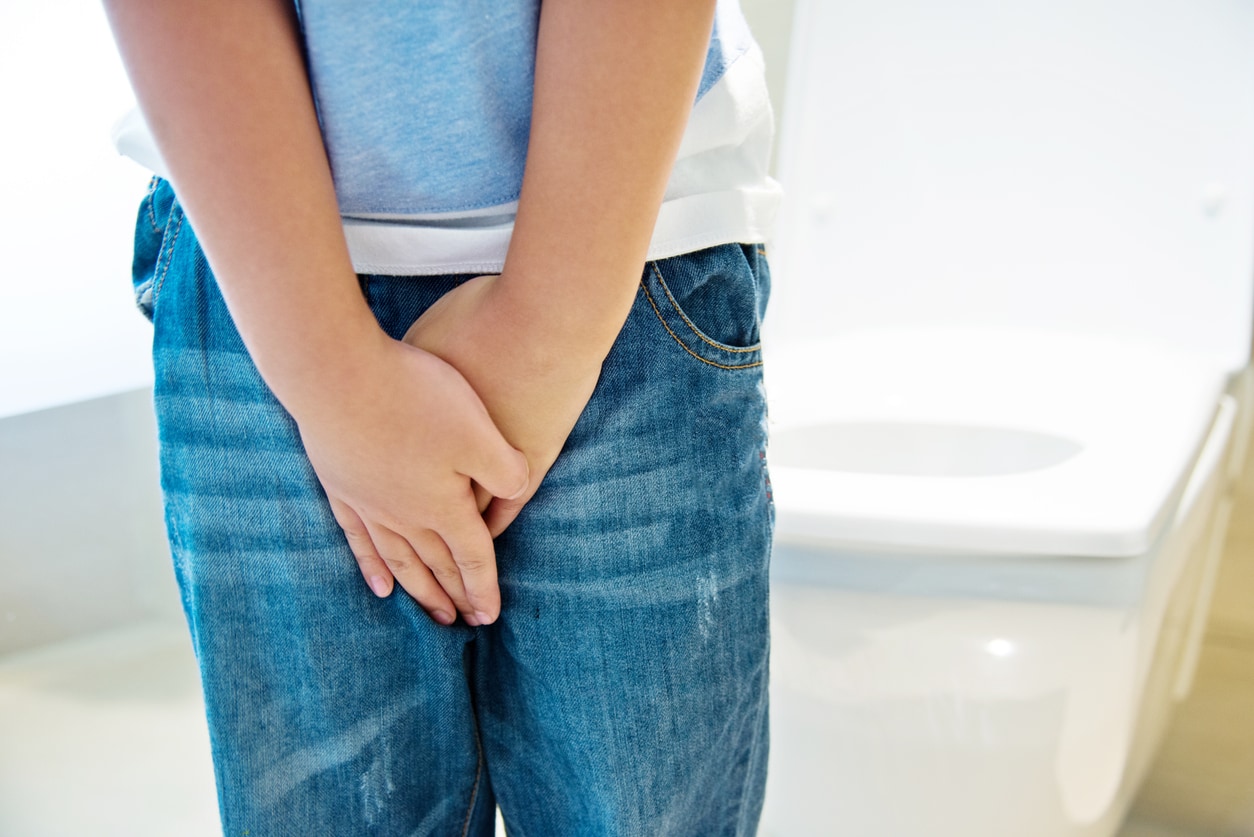Among the most misunderstood conditions I treat is daytime wetting, also known as diurnal enuresis or urinary incontinence. When children wet their pants, parents, daycare, and school personnel often assume these kids are too busy playing to use the toilet, that they’re stressed and seeking attention, or they’ve regressed in potty training and need more instruction. I’ve even had schools suspend patients for having accidents in class repeatedly.
But wetting accidents do not signal behavioral or psychological issues. They’re often caused by chronic constipation leading to a clogged rectum.
Poop Can Pile Up
When children delay pooping, as they often do, stool piles up in the rectum. Over time, the rectum stretches to accommodate the mass of poop, and the bulge presses against and aggravates the nearby bladder nerves.1,6
In the early stages of chronic constipation, aggravated bladder nerves may cause urinary urgency (the desperate, immediate urge to pee) and urinary frequency (the constant need to pee). But eventually, these nerves become so aggravated that the bladder contracts and empties — forcefully, randomly, and without warning. The contraction comes on like a hiccup or a sneeze: The child simply can’t stop it.
When this happens while the child is awake, it’s called diurnal enuresis. When it occurs overnight, it’s called nocturnal enuresis.2,3
That’s right: daytime accidents and nighttime accidents have the same cause. Bedwetting is not always caused by deep sleep, nor is it always caused by an underdeveloped bladder, urine overproduction, or stress.4
Daytime and Nighttime Wetting Go Together
Studies suggest about 5% to 10% of children experience daytime wetting, depending on their age, and many of these children also have nighttime wetting. Among tweens and teens with bedwetting, the prevalence of daytime accidents is much higher, about one-third.7,8
By the way, many kids with enuresis also have chronic poop accidents, known as encopresis — yet another symptom of chronic constipation. With encopresis, the stretched rectum loses tone and sensation, so poop drops out of the child’s bottom, often without the child noticing.
Whether a child develops daytime wetting, nighttime wetting, or encopresis depends on the extent of their constipation (more severe constipation usually means more daytime accidents) and how sensitive the child’s bladder is to the bulging rectum.
In a scenario that bewilders and frustrates parents, some children with daytime accidents don’t wet the bed. Parents wonder: If my child can sleep 10 hours without peeing, how can she not stay dry during the day? They conclude the child must be “acting out” or ignoring signals to pee.
But that’s not the case! Overactive bladders don’t follow the rules. My guess is the reclining position alters how the enlarged rectum affects the bladder, and kids with daytime but not nighttime wetting sleep in a position that renders their bladder nerves less aggravated at night.
Ultimately, it doesn’t matter why certain kids wet at certain times of the day. What matters is that these children are diagnosed with and properly treated for chronic constipation.
Diagnosing Constipation in Your Child
How can I be sure my enuresis patients are constipated? Because I x-ray them. You can’t argue with the image of a large stool mass clogging the rectum.
An average rectum measures about 3 centimeters in diameter. Among my enuresis patients, the typical rectum measures over 6 centimeters. In a three-and-a-half-year-old patient suspended from preschool for too many accidents, an x-ray revealed a stool mass the size of a Nerf basketball. The child had zero chance of staying dry yet was sent home for additional potty training.
I find x-rays are enlightening for parents. One mom told me: “My son’s x-ray showed his rectum was flattening his bladder. Seeing that decreased our frustration. We thought his accidents were a behavior or anxiety issue.”
She stopped rewarding her 5-year-old son for staying dry, and the boy stopped hiding his wet underwear.
The main reason I x-ray my enuresis patients is to rule out the rare wetting cases unrelated to constipation. For example, I had a 4-year-old patient with frequent daytime accidents whose x-ray showed an empty rectum. Further testing determined the culprit: posterior urethral valves, extra membranes that develop in utero and block urine flow through the urethra. Surgery corrected this rare condition.
In most cases, however, the cause of urinary incontinence in children is garden-variety constipation. Many parents are shocked when I explain their child is constipated, saying their child poops daily.
The Problem is Incomplete Pooping
But many chronically constipated children poop daily, even two or three times a day. They don’t fully evacuate. Incomplete evacuation is the problem.
The leftover stool accumulates, dries, and triggers a vicious cycle: large, hard stool makes pooping more painful, causing kids to delay pooping further. So, more poop piles up, stretching the rectum further.
Doctors often overlook constipation in children because today’s diagnostic methods are unreliable. Many ask the parents how often the child poops and feels the child’s belly (the report will usually say “no mass palpable”). But the rectum is stretchy, and a tiny, wiry child can harbor a considerable mass of stool the doctor cannot feel.
How to Treat Diurnal Enuresis
To resolve diurnal enuresis, you must empty the clogged rectum, and keep it clear for months, so it can shrink back to size and stop bothering the bladder nerves.
This can be more challenging than it sounds. Many folks, perceiving childhood constipation as a mild, temporary condition, turn to prune juice, a high-fiber diet, and maybe some MiraLAX, a common osmotic laxative.
But when a child is constipated enough to have accidents, MiraLAX may not suffice. High-dose MiraLAX “clean-outs” work temporarily at best and often accomplish nothing besides creating a mess and ruining the family’s weekend. The liquid cleanse washes right past the impacted stool.
Early in my career, I prescribed the enuresis treatment I’d learned in medical school: a MiraLAX clean-out followed by a daily maintenance dose of MiraLAX. Many of my patients did not improve.
Sifting Through Research
Delving into the published research. I discovered that in the 1980s, before the existence of MiraLAX, a Canadian team led by Dr. Sean O’Regan had great success treating diurnal and nocturnal enuresis with enemas — daily for one month before tapering to every other month.9
According to Dr. O’Regan’s team, aggressively treating constipation to allow for the evacuation of the rectum and its maintenance in an empty state until normal rectal tone returned resulted in a quick resolution of the enuresis.10
I conducted a three-month study in my clinic comparing Dr. O’Regan’s enema protocol to the typical MiraLAX regimen while tracking 60 children with daytime enuresis. Among the MiraLAX group, 30% stopped daytime wetting. In the enema group, 85% achieved daytime dryness.5
After three months, rectal diameter among the MiraLAX kids only reduced from 6 centimeters to 5 centimeters. The diameter in the enema group had shrunk to an average of 2 centimeters. Three children still wetting after three months remained clogged.
For stubbornly constipated patients like these, I recommend a stronger type of enema and sometimes overnight olive oil or mineral enemas, an old-school treatment validated by a recent Japanese study.11
Over the years, I’ve adjusted Dr. O’Regan’s enema regimen and call it the Modified O’Regan Protocol. I often combine enemas with osmotic laxatives, as enemas more effectively clean out the rectum, whereas laxatives keep poop soft, so pooping doesn’t hurt. Stimulant laxatives can also help.
Sometimes, I prescribe overactive bladder medication, but only when the patient is simultaneously working to resolve underlying constipation. Otherwise, drugs are useless.
In tough cases, I will inject Botox into the bladder wall, a highly effective (but expensive) treatment for daytime and nighttime wetting. But when without addressing underlying constipation, even this powerful, nerve-blocking drug is a temporary fix.
Treat Diurnal Enuresis Sooner Rather Than Later
Don’t wait around for your child to outgrow wetting. Left untreated, chronic constipation often worsens, and accidents become more frequent.
I have a large caseload of teenage enuresis patients who were told, year after year, “Don’t worry, you’ll outgrow it.” About one-third of my teen bedwetting patients have daytime enuresis, too. Let me tell you: wetting your pants in high school is miserable.
X-rays for enuresis aren’t necessary. Besides accidents, symptoms of constipation include large poops, infrequent pooping, underwear skid marks, stool formed like rabbit pellets or logs, stomach aches, and urinary frequency or urgency.
For a definitive diagnosis, ask your doctor for an x-ray. If your child proves to be constipated, treat constipation aggressively. In most cases, daytime enuresis resolves more quickly than bedwetting. Treating enuresis at age four is more manageable than treating the condition at age 14, but all daytime wetting cases will resolve with the proper treatment.

 PARENTING TIPS
PARENTING TIPS PREGNANCY
PREGNANCY BABY CARE
BABY CARE TODDLERS
TODDLERS TEENS
TEENS HEALTH CARE
HEALTH CARE ACTIVITIES & CRAFTS
ACTIVITIES & CRAFTS


